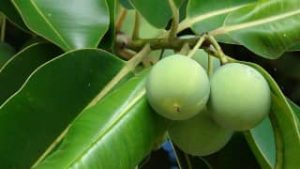Tamanu Oil Benefits - Acne, Eczema, Irritated skin, Wrinkles

More and more people find it very helpful to keep Tamanu oil or butter in the cupboard or family pharmacy. Why ?
This green oil with a spicy smell is a natural healer that also has antifungal and anti-inflammatory properties. Find out about its origin and its medicinal properties in more detail.
Tamanu tree – Origin and Description
The Tamanu belongs to the botanical family Guttiferae or Clusiaceae. Calophyllum inophyllum is its botanical name. The genus Calophyllum means beautiful leaf (from the Greek kalos = beautiful and phullon = leaf).
The tree is native to Southeast Asia and is found in Thailand, Burma, Malaysia, South India, Vietnam, Sri Lanka and in many islands of Melanesia and Polynesia.
The Calophyllum tree is known by different names in different geographical locations: Tamanu, Ati, Kamanu, Kamani, Fetau, Dolno, foraha or Dilo.
The Tamanu tree grows up to 25-30 meters in height and has long branches. The tree trunk is massive with a cracked bark of a brown or blackish color.
Traditionally, Tamanu wood is used in the manufacture of idols, sculptures and canoes. The glossy leaves, dark green, are quite large and oval. Its’ small white flowers with yellow centers offer a delicious fragrance. The tree’s green fruit, the size of an apricot is not edible.
The fruits contain a nut which is located in a kernel. The nuts are dried on a wire rack for about one to two months. These kernels change color and they become brown. They also become very sticky. Once this transformation has taken place, the oil can be easily extracted from the dark kernels using only mechanical pressure. A very heavy oil is extracted with 50 to 60% dry weight, which is to be purified by filtration and finally stabilized by natural vitamin E.
Composition of the Tamanu Oil
Tamanu oil contains 92 % neutral lipids, 6.4% glycolipids and 1.6 % phospholipids.
It also contains other therapeutically effective components : xanthones with an antiinflammatory effect (calophylline), triterpenes (friedelin, canophyllol), coumarins (calophyllolide, inophyllolide) of inophyllique acid, inophenique acid essential oils and vitamin E.
Benefits of Tamanu Oil – Key Properties
1) Natural Healing
Tamanu oil has therapeutic property of promoting the formation of new tissue, thereby accelerating wound healing and the growth of healthy skin. Because of its healing virtue, Tamanu oil is a natural remedy widely used in of first aid.
In the Pacific Islands, the Tamanu oil is applied liberally to cuts, scrapes, burns (boiling water, caustics and burning gas), sunburn, insect bites, scrapes, acne pimples, scars acne, psoriasis, diabetic sores, anal fissures, thrombosed hemorrhoids, dry or scaly skin, cracks, blisters, frostbite, psoriasis, eczema and herpes buttons.
Polynesian women apply tamanu oil to of their babies’ skin in a massage to promote beautiful (clear and unblemished) skin and prevent rashes such as diaper rash. Tamanu oil also has a soothing effect in the case of irritated skin.
2) Natural Anti-inflammatory
It has been shown that oil Tamanu has an anti- inflammatory action. This activity is due partly to calophylollide 4-phenyl coumarin and a group of xanthones in the oil and explains the reduction of the inflammatory response that usually accompanies all kinds of skin lesions: wounds, rashes, insect bites, acne pimples, etc. This oil is also traditionally used topically against sore throats.
3) Natural Antifungal
Tamanu oil has antifungal properties. Indeed, the friedelin molecule in Tamanu oil has a good antifungal action against Pseudallescheria boydii (responsible for fungal keratitis) and a moderate effect against Trichophyton schoenleinii (parasitic skin fungus on hair, skin and nails, associated with jock itch, ringworm, athlete’s foot, ringworm of the scalp and beard).
Tamanu oil contains fractions of n-butanol which exert an antifungal action against Trichophyton including SEMII metagrophyte and Trichophyton.
4) Antibacterial Properties
Tamanu oil also has natural antimicrobial properties. The oil contains several powerful effective bactericidal agents to combat human and animal pathogens.
These antimicrobial phytochemicals include friedelin, canophyllol, canophyllique acid and inophynone. They exert direct and indirect antibiotic effects by stimulating the phagocytic cells of the reticulo-endothelial system (macrophages).
Researchers have compared the Tamanu’s antimicrobial activity with that of ampicillin. They observed that the canophyllol has a good antimicrobial action against Staphylococcus aureus (S. aureus) bacteria that cause abscesses, boils, infected wounds, inflammation, suppuration, septicemia and conjunctivitis.
In addition, the canophyllol in Tamanu oil acts against Corynebacterium diphtheriae (responsible for diphtheria), Klebsiella pneumoniae (responsible for sepsis, respiratory infections, infected wounds and burns).
The canophyllic acid acts moderately against Proteus mirabilis, which is the cause of bladder infections, sores, sepsis and pneumonia, particularly in hospitalized patients.
The researchers concluded that the antimicrobial agents in Tamanu oil can be used successfully to treat a number of skin and eye infections.
5) Analgesic properties of Tamanu oil
Whether used in rubbing or massage, Tamanu oil has analgesic properties and is used to relieve neuralgia, leprous neuritis, shingles, rheumatism, painful joints, sprains, tendonitis, sprains, back pain and sciatica.
6) Antioxidant Activity of Tamanu Oil
The coumarins and xanthones in Tamanu oil have antioxidant properties. They particularly inhibit lipidic peroxidation. The cell membranes are made of lipids.
The antioxidant activity of Tamanu oil helps protect the skin cells against damage caused by oxidative damage. Tamanu oil is recommended for preventing the appearance of wrinkles and stretch marks.
7) Protective Power on blood vascular system
Tamanu oil promotes blood circulation and protects small capillaries. It is sometimes used to treat rosacea. Since it increases the microcirculation, it is also indicated in the problems of ‘heavy legs’.
8) Action Moisturizer
Tamanu oil contains more than 35% of a polyunsaturated omega-6 fatty acid (linoleic acid), which participates in reconstituting the epidermal lipids and has the property to prevent water loss from the skin while providing soothing, protective and nutritious qualities.
This oil is ideal for rehydrating and revitalizing dry or damaged skin.
9) Natural Whitening
The oil is also used in Madagascar for lightening dark skin.
10) Natural Deodorant
The oil is also used to reduce body and foot odor.
Cosmetic Use of Tamanu Oil
Tamanu oil has a pleasant aroma and texture that leaves the skin smooth and soft without leaving an oily residue. It is increasingly used in aromatherapy and cosmetic preparations such as solar products (a 1% formula induces a 74% protection against UVB), hair care products, facial care (moisturizers, restructurers, and anti-wrinkles) and makeup products.
Important Recommendations
Thanks to its healing, anti-inflammatory and antimicrobial properties, Tamanu Oil is a useful natural remedy to treat a wide range of skin conditions.
Tamanu oil can be applied undiluted or pure directly on the skin. Be aware that this pure oil should not be applied directly to the skin on prolonged due to its acidity and its rubefacient action.
That is why this oil « with a thousand virtues » is generally mixed with other medicinal oil (or butter cosmetic) to avoid irritating the skin.
There are no reports of adverse effects caused by the application of Tamanu oil.
Because Tamanu oil has a mild anticoagulant effect, oral use should be avoided if you are taking anticoagulants or if you are prone to bleeding. Talk to your doctor.
Author : Alexis ROGER
Weight Loss Juice with Parsley
Brain Teaser
__________

